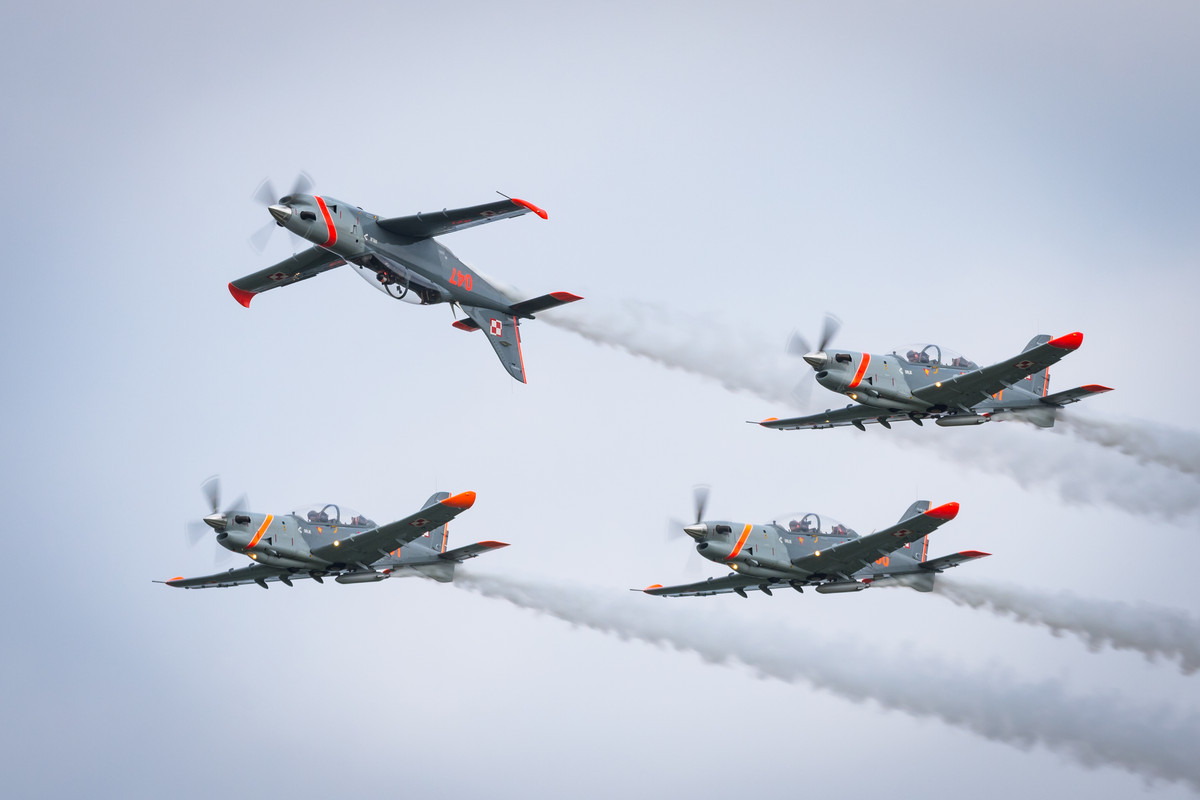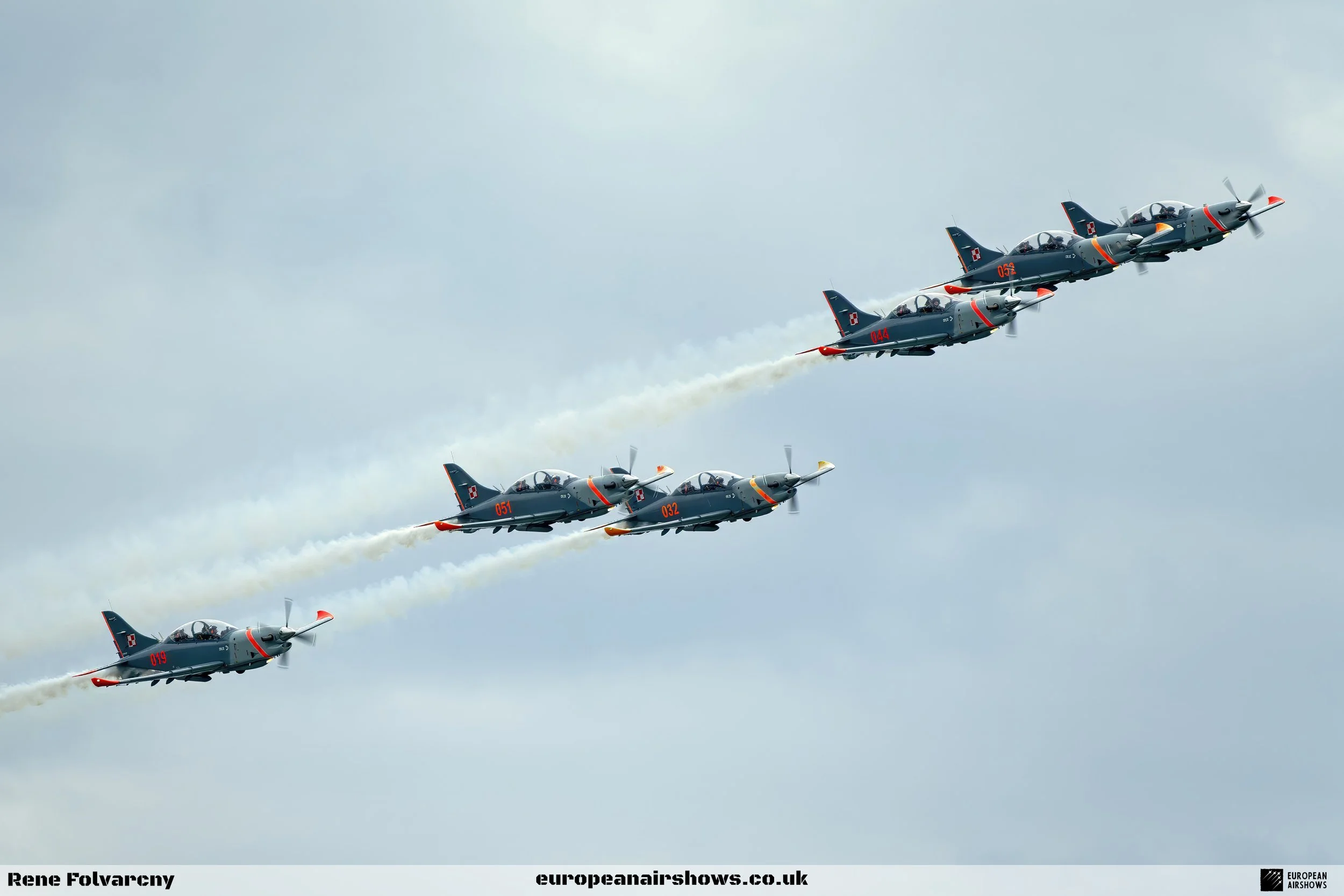
Aerobatic Team Orlik
About the Team
The Aerobatic Team “Orlik,” known in Polish as Zespół Akrobacyjny “ORLIK,” stands as a distinguished emblem of the Polish Air Force, showcasing the pinnacle of aerobatic excellence. Formed in 1998 at the Polish Air Force Command College, this team has become synonymous with precision flying and breathtaking aerial performances. Stationed at the 42nd Air Base School in Radom, the team’s operational heart beats within this historic military installation, where they train and hone their skills.
The aircraft that the team flies is the PZL-130 Orlik, a sleek and agile turboprop trainer crafted in Poland, which lends its name to the team. The choice of this aircraft is significant, as it not only represents national pride but also provides the ideal platform for developing the intricate maneuvers that define their performances. The team is composed entirely of highly skilled pilots who serve as instructors at the 42nd Air Base School, ensuring that the members possess not only exceptional flying abilities but also the pedagogical skills necessary to train the next generation of aviators. The selection of new candidates is a meticulous process, conducted by the team leader in collaboration with other current members, fostering a strong sense of unity and shared purpose among the pilots.
Team Overview
Number of Aircraft
3 to 6
Established
1998
Based
Radom air base
Aircraft Type
PZL-130TC II Orlik
About the aircraft
The PZL-130 Orlik, designed by PZL Warszawa-Okęcie, is a Polish turboprop, single-engine, two-seat trainer aircraft developed to replace the PZL-110 Koliber for the Polish Air Force. The first prototype flew on October 12, 1984, and subsequent prototypes were developed, including a turboprop variant, the PZL-130T Turbo Orlik, which first flew on July 13, 1986. The project transitioned from piston engines to turboprop engines due to insufficient power from the locally produced radial engines. By the early 1990s, the PZL-130TB variant, powered by the Walter M-601 turboprop, became the primary model, with upgrades leading to the TC-1 standard featuring improved ejection seats and avionics.
The PZL-130TC II Orlik is an advanced variant that builds on the capabilities of its predecessors, equipped with a Pratt & Whitney Canada PT6A-25C turboprop engine for enhanced performance. It features winglets for improved aerodynamics and modern Garmin avionics for better navigation and flight management. The aircraft also offers a redesigned flight tutor’s seat for improved ergonomics. Additionally, the PZL-130TC II Orlik (GC) variant includes a glass cockpit and a Head-Up Display (HUD), branding it as the Orlik MPT (Multi Purpose Trainer), showcasing its versatility for contemporary military pilot training.
Team History
The history of the Aerobatic Team “Orlik” is a tale of ambition, resilience, and aerial artistry. It all began with their first public performance on April 15, 1998, a moment that signaled the birth of a new chapter in Polish aviation. The team’s debut was met with enthusiasm and marked the beginning of a journey that would soon take them beyond the borders of Poland. Later that same year, they made a significant international appearance at the renowned Royal International Air Tattoo held at RAF Fairford in England, introducing their remarkable skills to a global audience.
Initially, the team comprised four pilots, with three focusing on formation flying and one designated as a solo performer. As the team’s reputation grew, so did its ranks. By the end of 2000, the team expanded to include seven aircraft, and they even reached a peak of nine aircraft in subsequent seasons. This made them one of the few turboprop aerobatic teams capable of executing such large formations, showcasing their unique capabilities and thrilling spectators with complex aerial displays.
However, the team’s journey was not without its challenges. In late 2005, military authorities made the difficult decision to disband the team after an impressive run that included participation in 49 air shows, with 20 of those taking place abroad. During this period, Orlik captivated audiences across Europe, performing in countries such as the United Kingdom, Spain, Greece, France, Italy, Belgium, the Netherlands, the Czech Republic, Slovakia, and Lithuania. Their performances were not only visually stunning but also earned them numerous accolades, solidifying their status as a premier aerobatic team.
The story of Orlik took a remarkable turn in mid-2007 when the team was reborn under the command of Lt. Col. pil. Arkadiusz Leśniewski. With a renewed spirit and a fresh lineup of seven aircraft, the team once again took to the skies, eager to reclaim their place in the world of aerobatics. Since 2013, Orlik has been a regular feature at nearly all major Polish airshows, as well as at significant events across Europe, dazzling audiences with their skill and precision.
Today, the Aerobatic Team “Orlik” continues to evolve, offering a variety of displays that highlight their versatility. The number of aircraft available to the team can influence the size of their formations, as the training of new pilots remains their top priority. Consequently, the team may perform with smaller formations when fewer aircraft are available, ensuring that their primary mission of training is not compromised. Whether executing a solo performance or intricate formations involving three, four, or even six aircraft, each display is a testament to the pilots’ dedication and teamwork. The legacy of Orlik lives on, inspiring awe and admiration as they soar through the skies, embodying the spirit of the Polish Air Force and the artistry of aerobatic flight.
Did You Know?
- The Aerobatic Team “Orlik” was formed in 1998 and is based at the 42. Air Base School in Radom, Poland, where all pilots serve as instructors.
- The PZL-130 Orlik, which is the aircraft used by the team, was designed to simulate the handling characteristics of jet fighters, making it an ideal trainer for aspiring pilots.
- The team initially started with four aircraft and expanded to seven, occasionally performing with as many as nine aircraft, making it one of the largest turboprop aerobatic teams in the world.
- Between 1998 and 2005, the team participated in 49 air shows, showcasing their skills not only in Poland but across various countries including the UK, France, and Italy.
- The PZL-130 Orlik has several variants, including models equipped with advanced avionics and ejection seats, demonstrating the evolution of the aircraft over time.







































